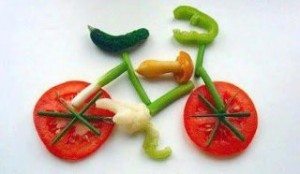By Ilana Katz MS, RD, CSSD
Athletes are well aware that carbohydrates are their main source of energy, particularly during activity. Seems simple enough, but all carbohydrates are not the same. Carbohydrates (carbs) are categorized as either simple or complex. Simple carbs, commonly known as sugars, occur in the form of either a monosaccharide (one-sugar unit) or a disaccharide (two units). Complex carbs are polymers of simple carbs (many sugar units). Carbs are the main functional ingredients in sports nutrition products, mainly drinks and gels. So the question becomes, “Which carb is the right for me?”
In reality, there are no major difference in the effects of any of the most commonly used carbs (fructose, maltodextrin, sucrose, glucose, dextrose, galactose) on performance. But there are differences in absorption rates, levels of sweetness and thus appeal. Analyzing how sports nutrition product manufacturers decide upon the combinations of carbohydrates they use may answer the athlete’s question as to what is the best drink/gel to fuel their athletic performance.
Athletes must choose a product whose absorption rate agrees with their individual gastrointestinal sensitivity. Factors that affect carbohydrate absorption rate include concentration, volume, solubility, and the Glycemic Index of the carbohydrate. Concentration is the energy content (calories) of the carbohydrate in solution. A small concentration of carbohydrate results in rapid travel from the stomach to the small intestine. Research shows that a 6-8-percent concentration of carbs has an optimal gastric emptying rate. Stronger concentrations in the stomach attract more fluids to the gastrointestinal system, and not only result in a bloated, uncomfortable, sluggish stomach, but simultaneously draw fluids away from other areas of the body where they are needed.
The Glycemic Index (GI) measures how fast the carbohydrate of a particular food is converted to glucose and enters the bloodstream. Many athletes believe that consuming low glycemic carbs before exercise provides a long-lasting source of fuel. However, research does not support this notion. Research does, however, support consuming moderate to high GI carbs during activity, as it raises carbohydrate availability and, therefore, enhances endurance and performance (1).
Fructose is a monosaccharide, has a unique digestive pathway, and is the preferred simple sugar that restores liver glycogen, a stored form of fuel. Fructose also has a fairly low glycemic index. Together with its being a sweetening agent, these qualities favor its use as a carbohydrate in sports nutrition products. Due to its need to be metabolized by the liver, however, it has a slow absorption rate and sports drinks that contain mainly fructose may cause gastrointestinal distress. Thus, fructrose used alone is not the ideal carb for optimal performance.
Sucrose is absorbed more rapidly than fructose. It is a simple, easily digested sugar with a mid-range glycemic index. Furthermore, it has a pleasant sweetness and palatability. Consumers are often concerned that sucrose, being table sugar, causes weight gain. Certainly, in large amounts, as with any other sugar, sucrose may have an effect on weight. However, as an ingredient in a sports drink and consumed in moderation, it has positive qualities as a fuel source.
Maltodextrin, because of its complete solubility, is an ingredient found in many sports nutrition products. Complete solubility leads to less risk of gastrointestinal distress. Maltodextrin is a polysaccharide with building blocks of glucose. Even though the bonds need to be broken for fuel availability, maltodextrin digestion does not put undue stress on metabolic processes. The resultant glucose molecules then enter the blood stream immediately, providing an instant source of energy.
Dextrose is a simple sugar with a high glycemic index and thus provides a rapid source of fuel. It is also known to stimulate gastric emptying as well as sodium reabsorption from the kidneys, which is beneficial for hydration. Dextrose may add appeal with its pleasant sweetness, and unlike fructose, dextrose requires no liver metabolizing before getting into the muscles as a fuel. It is therefore a coveted ingredient for sports products.
Carbohydrates are often used in combination in sports nutrition products in order to balance their positive and negative effects. High glycemic index carbs, such as glucose and dextrose, are often be combined with lower glycemic index carbs such as fructose and galactose, a monosaccharide that is also not digestively demanding. This combination reduces the high insulin response associated with high glycemic index carbs yet it is quickly absorbed. Fructose and maltodextrin are often found in combination. Fructose enhances the sweetness of the bland, flavorless maltodextrin, and similarly, maltodextrin removes the unpalatable over sweetness of fructose.
Sports nutrition products often have fructose as an ingredient because of its unique digestive pathway. Alone, as mentioned above, it may induce gastrointestinal distress, but in combination with other carbs it enhances total carbohydrate availability because it can still be absorbed even when the pathways used by other carbs have been saturated. It is thus best as a secondary carb source. The words “high fructose corn syrup” a processed food component derived from fructose and glucose, are therefore almost inevitable on a sports nutrition product ingredient list. This component is worth mentioning due to the negativity surrounding it and its perceived role in the obesity epidemic. This is unfortunate because any nutrients or foods consumed in unnaturally high doses are the real reason for obesity (2).
Choosing sports nutrition products is an individual matter and athletes are advised to experiment with different products. Factors affecting choice may include duration and intensity of exercise and climate (extreme conditions can alter the gastric emptying rate). Sugars provide fuel to working muscles. An optimal combination would be readily absorbed with an appealing taste. One man’s sweet is another man’s gastric issue; therefore, optimal carbohydrate fuel does not necessarily come from one sugar source but from a preferred combination.
References:
1. Burke et al. Glycemic Index: A new tool in Sports Nutrition. Int J Sports Nutr. Dec 1998; 8(4), 401-15.
2. The truth about High Fructose Corn Syrup. www.poweringmuscles.com.



Wow, that’s a great artical on nutrition. With my health problems I’m looking for the best. I think I just found it.
Could we please exchange links, maybe you could “I like” my webpage.
Thanks Craig